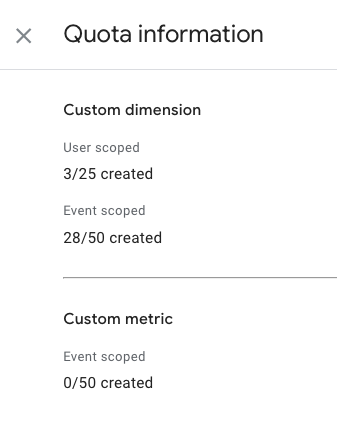Google Analytics 4 vs. Google Analytics 3: What are the pros and cons?
Why you should switch to GA4 as a free Google Analytics user now (and what you will have to miss out on)
- Article
- Technical Web Analytics
- Data Analytics


If you want to keep track of free statistics about website visitors and their behaviour on your website, you will quickly turn to Google Analytics. With the free version of Universal Analytics (better known as GA3), it only takes a few minutes to set up basic metrics such as users, sessions and pageviews. For more extensive analyses, you have the paid version Google Analytics 360. As of July 2023, GA3 will no longer be supported by Google. Time to switch to the new GA4. Read all about the pros and cons of the new Google Analytics in this article.
Update: on 1 July 2023, data processing will stop for standard Universal Analytics (GA3) properties. GA360 properties still have until 1 July 2024 to switch to GA4.
Although Universal Analytics is free, many large e-commerce organisations use the tool. For in-depth data issues, the free version of Google Analytics often offers sufficient options. You can set up up to 25 different data views within the Universal Analytics interface. You can also add 20 custom dimensions and metrics to the dataset.
To be able to use these functionalities, you need a Technical Web Analyst who, for example, makes the data available for Google Analytics using tools such as Google Tag Manager.
Collect unlimited data in Google Analytics 4
In the long run, as a growing company you will run into one of the main limits of Universal Analytics, namely being able to process only a limited amount of data. This is where Google Analytics 4 opens up huge opportunities for free users.
Since the launch of Google Analytics 4 in 2020, this version of the tool no longer has data collection restrictions. While the free version of Universal Analytics allows the processing of 10 million hits per month, Google Analytics 4 allows you to collect infinite data.
The benefits of moving from Google Analytics 3 to Google Analytics 4
For free users, there is a lot to gain from moving to Google Analytics 4:
Advantage 1: no data sampling in default reports
Data sampling in default reports is the most common complaint from free Universal Analytics users: you want to add a little more depth to your reports and then get a sampled report back from Google. You can hardly do anything with the insights from this report.
For those who can no longer stand the dreaded yellow check mark, Google Analytics 4 offers a solution. All default reports are un sampled so that you can gain insights over longer periods.

Advantage 2: Measuring more custom dimensions and conversions
In Universal Analytics, you can associate only 20 custom dimensions and metrics with a property. Those who have an extensive implementation will often quickly run against this limit. Fortunately, there are more possibilities in Google Analytics 4. A distinction is now made between custom dimensions on user and event scope. The quota for user scope custom dimensions is 25 while it is 50 for event scope parameters. As a free user, this gives you much more space to collect data specifically for your organisation. In addition, custom dimensions in Google Analytics 4 are no longer linked to an index number and can be easily archived when they are no longer relevant.

Advantage 3: More options for measuring conversions
Google Analytics allows users to me as ure how a website or app contributes to achieving an organisation's objectives. In addition to e-commerce transactions, you can also measure other objectives. Think of mailing list registrations and brochure requests. You can create goals for this in Universal Analytics. 20 per view, and they can be based on a page view or an event. In Google Analytics 4 the data views have disappeared and 30 conversions per property can beregistered. Conversions in Google Analytics 4 are always based on an event, but unlike Universal Analytics, events can now also be linked to segments and user navigation steps. This allows conversions to be registered in great detail. For example: a conversion is only measured when a user visits several pages where several parameters show certain values. For example, for digital-power.com we can create a conversion in GA4 for 'interest in GA4' where a user has read one or more pages on our website about GA4 and then subscribed to our newsletter. In GA3 you would not be able to use this combination of pageviews and events to register a target conversion.
Advantage 4: advanced analytics capabilities
If you want to deal with more complex issues with Universal Analytics data, you will quickly fall back on the Google Analytics API for sheets. For free accounts, this too comes with restrictions in terms of data sampling. As a result, the analysis options are ultimately quite limited.
With Google Analytics, Google makes 4 resources available to free users that were only available to paid users in Universal Analytics. Within the Google Analytics 4 interface, just like in Google Analytics 360, you can create 'Explorations' with which you can easily create visualisations based on dimensions and metrics of your choice.

Outside the interface of Google Analytics 4, it is also possible to link a Google Analytics 4 property to a Google BigQuery project. There are costs associated with this option (in the long run), but on the other hand, you can now make very complex analyses over an unlimited number of rows of data. In addition, with Google BigQuery you can also link your Google Analytics 4 data with dashboarding tools such as Microsoft Power BI.

The disadvantages of switching from GA3 to GA4
Despite the many advantages that a migration from GA3 to GA4 brings, there are also a number of GA3 features that are not transferred to GA4. As a result, you miss out on certain functionalities that you are used to. We are happy to explain the main changes.
Disadvantage 1: differences in the gtag.js library with Universal Analytics
If you currently already have a Universal Analytics implementation, you'll need to post a new code snippet on the site to get Google Analytics 4 working. We recommend doing this through Google Tag Manager and are happy to monitor things if you want us to.
If the data needs for your site are limited, there is a good chance that the default code snippet will help you sufficiently. Google Analytics 4 offers the option to enable 'advanced measurements' in the settings. When these are active, page_view, scroll, click and YouTube video events are automatically sent to Google Analytics 4.
Is your implementation more extensive and do you already use Google Tag Manager to measure events? Then you will have to place new tagging for Google Analytics 4. If you have an enhanced e commerce implementation for Universal Analytics, you will have to adapt it, including the data layers, to the Google Analytics 4 format.
Disadvantage 2: no more data views
In the section on goals/conversions, we already mentioned the loss of data views (also called views). Views make it very easy for users to divide their dataset into different components (eg separate views fort he Netherlands and Belgium). However, Google has been struggling for some time with the high costs involved in facilitating these views and has therefore decided to no longer make them available in Google Analytics 4. Only paying users can create a so-called 'sub property' for an additional fee. As a result, when migrating from Universal Analytics to Google Analytics 4, it is important to carefully consider the structure of the implementation and which KPIs are fundamental to the business.
Disadvantage 3: No more custom channel groupings
A favourite component of many marketers has been Universal Analytics' custom channel grouping. This allows admins to name marketing channels themselves and indicate which sources / media fall under a channel. In Google Analytics 4, Google only offers the default channel grouping. It is there fore also important to review Google's documentation and see which resources/media they allocate to their predefined channels.
Is custom channel grouping an absolute must for your team? The nit might be worth making a custom channel grouping in Google BigQuery and using it in, for example, a Google Datastudio dashboard.
Disadvantage 4: not all features have been delivered yet
Despite the fact that Google already announced that Universal Analytics will disappear in July 2024 (free verison in July 2023) not all features of Google Analytics 4 have been delivered yet. In the e-commerce module, for example, item-related parameters are still missing. In the traffic reports it is not yet possible to view the dimensions linked to utm_keywordandutm_content.
This can be problematic for end users. Fortunately, Google is currently still in a transition phase and you therefore still have access to your GA3 reports. These will disappear in July 2024, so you really have to make the switch for that.
Disadvantage 5: your dashboards no longer work
Do you use GA3 data for dashboarding in, for example, Google Data Studio or Microsoft PowerBI? Then you will have to create a new link* between GA4 and your dashboarding tool. Depending on the layout of your dashboards, you have to build your visualisations differently. Want to take your dashboards to the next level? Then link your GA4 property with a Google BigQuery project and build tables that you use as source files for your dashboards. In this way, your dashboards become much faster and data sampling no longer occurs.
*If you want to link GA4 withPowerBI, this must be done in Google BigQuery. We are happy to help you with this.
Do you need advice on or help with the transition from GA3 to GA4?
Our data specialists are happy to help. Can we help you with a seamless transition, without losing important web data? Contact us.
Receive data insights, use cases and behind-the-scenes peeks once a month?
Sign up for our email list and stay 'up to data':


